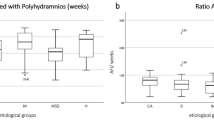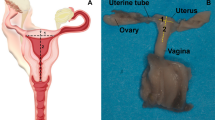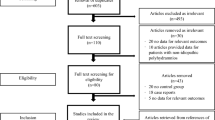Abstract
OBJECTIVE:
The objective of this study was to identify maternal and infant characteristics related to alteration of amniotic fluid volume at birth.
STUDY DESIGN:
A series of 27,145 consecutive malformed newborn infants from the Spanish Collaborative Study of Congenital Malformations (ECEMC) was analyzed. From this total, 3.01% were found to have oligohydramnios and 3.69% were found to have polyhydramnios.
RESULTS:
As expected, renal/urinary tract and lung defects were associated with oligohydramnios, whereas esophageal and intestinal atresias, neural tube defects, and other central nervous system malformations were associated with polyhydramnios. In addition, other defects such as cardiovascular anomalies, hydrocephaly, and microcephaly were also related to abnormalities of amniotic fluid volume. After excluding the defects whose association to oligo- or polyhydramnios is well recognized, we compared the frequency of different variables among them and with infants with a normal volume of amniotic fluid. In comparison with infants with normal amniotic fluid volume, the groups with oligo- and polyhydramnios had lower birth weight, shorter gestational age and umbilical cord, higher parental ages, and a greater frequency of spontaneous abortions. The differences were more marked for weight in newborn infants with oligohydramnios, and for gestational age, umbilical cord length, number of previous pregnancies, and spontaneous abortions in polyhydramnios cases. Placental weight was lower in oligohydramnios cases than in infants with normal amniotic fluid, and higher in polyhydramnios cases. Parental consanguinity and twinning were more frequent in polyhydramnios. Maternal morbidity was higher in both groups with abnormal amniotic fluid volume, especially for acute diseases such as hypertension, diabetes mellitus, and gestational diabetes. Chromosomal aberrations were more frequent in the oligo- and polyhydramnios groups than in cases with a normal volume of amniotic fluid, which supports the suggestion of performing prenatal cytogenetic analysis in any pregnancy complicated by an abnormal volume of amniotic fluid.
CONCLUSION: The fact that all of these results are similar in the control group of healthy infants suggests that at least some of the variables associated with abnormal amniotic volume could be considered as causal factors altering the production of fluid.
This is a preview of subscription content, access via your institution
Access options
Subscribe to this journal
Receive 12 print issues and online access
$259.00 per year
only $21.58 per issue
Buy this article
- Purchase on Springer Link
- Instant access to full article PDF
Prices may be subject to local taxes which are calculated during checkout
Similar content being viewed by others
Author information
Authors and Affiliations
Additional information
This work was supported in part by a grant from Instituto de SaludCarlos III, Ministerio de Sanidad y Consumo (Madrid, Spain), and byFundación 1000 Para la Investigación sobre DefectosCongénitos of Spain.
Rights and permissions
About this article
Cite this article
Martínez-Frías, M., Bermejo, E., Rodríguez-Pinilla, E. et al. Maternal and Fetal Factors Related to Abnormal Amniotic Fluid. J Perinatol 19, 514–520 (1999). https://doi.org/10.1038/sj.jp.7200259
Published:
Issue Date:
DOI: https://doi.org/10.1038/sj.jp.7200259
This article is cited by
-
Amniotic fluid disorders and the effects on prenatal outcome: a retrospective cohort study
BMC Pregnancy and Childbirth (2021)
-
The association between pregnancies complicated with isolated polyhydramnios or oligohydramnios and offspring long-term gastrointestinal morbidity
Archives of Gynecology and Obstetrics (2019)
-
Aminotic Fluid Index and its Correlation with Fetal Growth and Perinatal Outcome
Journal of Fetal Medicine (2015)
-
Epidemiology of isolated preaxial polydactyly type I: Data from the Polish Registry of Congenital Malformations (PRCM)
BMC Pediatrics (2013)
-
Is oligohydramnios more common during the summer season?
Archives of Gynecology and Obstetrics (2009)



